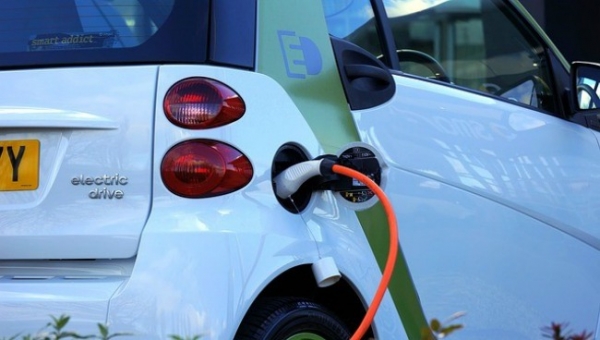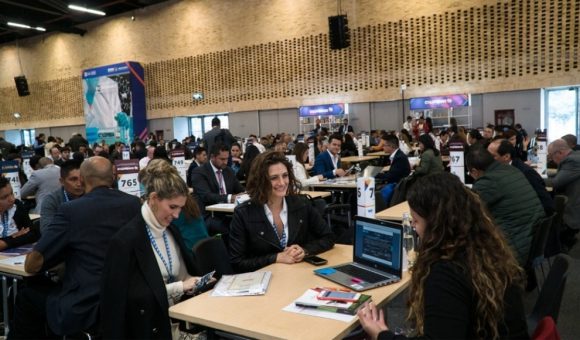Massive Electric-Vehicle Adoption Would Slash Pollution: Medellin EV Conference

More than 500 attendees from 11 nations attending the “Second International Conference on Electric Mobility” in Medellin September 25-26 heard from dozens of international and national experts on the need to speed-up the nascent adoption of electric vehicles (EVs) here.
Such an acceleration of EV adoption would slash air pollution, improve public health, reduce energy-import dependence and cut “global warming” emissions, according to expert speakers here.
Meanwhile, “range fear” – a crucial consumer issue that heretofore has hobbled EV adoption — is declining, as Colombia now has two EVs offering 300-kilometers autonomy between recharges – the Renault “Zoe” five-passenger sedan, sold at COP$99 million/US$33,000, and the BMW “i” sedan, at COP$150 million/US$50,000.
What’s more, China-based BYD is now offering a 400-kilometers autonomy “E5” five-passenger sedan in Colombia, at COP$107 million/US$35,600. Having first launched sales in Bogota, BYD is now debuting a new-car showroom and maintenance shop in Medellin, due in October.
Nissan also has its prior-generation, 200-kilometer-autonomy “Leaf” available here at COP$117 million (US$39,000). But the company hasn’t yet decided whether to launch a longer-autonomy version for Latin America next year.
In addition, Medellin-based national motorcycle assembly and marketing giant Auteco is offering several varieties of “Starker” electric motorcycles and bicycles, at prices that would seem to be affordable even for low-income individuals and families.
However, “e-motorcyles” and “e-bikes” would be even more attractive to lower-income families if Colombia eliminated import taxes and value-added taxes on such vehicles — and if governments incentivized wider construction and deployment of public “e-motorycle” recharge stations, according to the company.
Auteco sold more than 4,000 EV motorcycles in Colombia last year – a drop in the bucket compared to the 8 million gasoline-fueled motorcycles in Colombia, however. What’s more, the Medellin metro area is now hosting more than 700,000 motorcycles, accounting for the single biggest chunk of air pollution among all types of vehicles.
Gasoline-engined motorcycles of less-than-125-cubic-centimeters displacement account for more than 95% of Colombian motorcycle sales, as these enjoy tax exemptions. Problem: Such motorcycles are not only cheap, but also relatively “dirty” in tailpipe emissions.
The annual Electric Mobility conference, this year in Medellin — organized by the United Nations-accredited World Energy Council (WEC) — aims to help nations and municipalities overcome environmental, economic, energy and social problems caused by pollution from internal combustion engines (ICEs).
In a keynote presentation here, WEC-Colombia chapter president Jose Antonio Vargas — who’s also the president of Italy-based power giant Enel’s “Codensa” power subsidiary in Colombia — cited enormous public-health costs of air pollution, especially cardiopulmonary diseases triggered by ozone and particulate matter (PM) emissions mainly from vehicles in cities.
But there’s hope on the horizon, as zero-emissions EV costs are falling in concert with the plunging cost of the most expensive component: batteries. This would make EV cars and motorcycles attractive to vast numbers of middle-class and lower-income Colombian families, he showed.
In 2018, EV battery costs were 43% of the total cost of electric cars, at around US$240 per kilowatt-hour (kWh), Vargas showed.
However, that’s down from US$400/kWh only four years ago – and battery costs are seen falling to around US$100/kWh sometime between 2025 and 2030, making EVs cost about the same as ICE cars, he showed.
Meanwhile, big cities including Medellin are facing ever-worsening air-pollution crises mainly caused by ICE vehicle pollution, with a new alert just issued for the month of October.
As a result, the Area Metropolitana del Valle de Aburra (AMVA, the Medellin metro council of governments) just expanded “pico y placa” orders banning circulation of ICE vehicles during certain hours, with vehicle rotations based on odd/even license plate numbers.
The “pico y placa” restriction exempts zero-emissions EVs. But that exemption is only one of a very few Colombian local or national government incentives for EV purchases. As a result, today’s EV incentives aren’t nearly big enough to encourage faster turnover of ICE fleets to EVs, Vargas argued.
While China is leading the world in massive EV production, development, deployment and government incentives, in Latin America, Chile is taking the regional lead toward EV adoption, as a law first adopted in 2014 imposes a US$1,000 extra charge on gasoline and diesel-fueled vehicles — while electric power tariffs are cut 30% for EV owners recharging at night, he noted.
While home- or office-based charging accounts for the vast majority of EV recharges everywhere in the world, Chile has rapidly expanded public-access charging as well. What’s more, the Chilean government offers subsidies of up-to-US$8,000 for purchase of EV taxis, and the city of Santiago is moving to replace old, “dirty” diesel buses with 2,000 electric buses by 2025, he showed.
Neighboring Ecuador also offers relatively hefty incentives for EVs including restrictions on ICEs for inner-city travel, exemptions from value-added tax and import duties, and elimination of the former limit of 1,000 EV imports per year. As a result, Ecuador now expects that at least 22% of all new cars bought there by 2032 will be EVs.
As for Colombia, the only incentives for EV purchases are a reduction in value-added tax (to 5% instead of 19%) on new EV cars. However, the government is only allowing the duty-free import of 1,500 EVs per year, greatly restricting market access.
Ironically, the national electric-power planning agency (UPME) has set a goal to require at least 400,000 EVs in Colombia during the next decade. Yet at the same time, other government agencies are severely restricting EV imports or delaying imports via cumbersome reporting regulations, experts pointed-out here.
Meanwhile, Medellin Mayor Federico Gutierrez announced September 13 that the city aims to have “streets free of ICE vehicles by 2030,” and newly elected Colombia President Ivan Duque is promising to promote “massive” deployment and use of EVs in Colombia.
However, only 754 EVs were bought in Colombia last year, out of a total passenger vehicle fleet of 5.8 million cars and 8 million motorcycles, WEC’s Vargas noted.
Today’s EV passenger sedans in Colombia can cost two-to-three times as much as comparable ICE cars, although future EVs are likely to be much cheaper within about five to seven years, he said.
However, Colombia’s cities can’t wait to crank-up the battle against choking air pollution, he said.
Which is why government agencies should move to eliminate value-added tax on EVs through 2030, eliminate limits on tariff-free imports, impose higher taxes on dirty fossil fuels and vehicles, speed-up adoption of electric transit buses, public-fleet vehicles and taxis, move to impose much-tougher “Euro-6” tailpipe emissions limits, allow companies and individuals to deduct the cost of EV recharge stations against taxable income, require public EV recharge stations to be included in new buildings, require builders of the new “4G” inter-departmental highways to install public EV recharge stations, and allow EV owners to enjoy a discounted annual vehicle-circulation-tax, he said.
Medellin ‘E-Taxi’ Plan Hits Snag
On a related front, Medellin’s plan to have 1,500 EV taxis by 2020 has hit a snag as project participant EPM pulled-back on earlier promises to subsidize the scheme – due to financial problems arising from the troubled “Hidroituango” hydroelectric plant in Antioquia.
In a post-presentation interview here, EPM commercial director Juan Rafael Lopez confirmed to Medellin Herald that the “Hidroituango” problem forced the electric utility to cut funding for the proposed E-taxi project — with the result that multi-party “structuring” discussions are now trying to unblock the project with alternative schemes.
In a separate interview following his presentation here, Medellin Mobility Secretary Humberto Iglesias told Medellin Herald that the multi-party discussions are considering a new, two-tiered tariff structure that would allow “green” EV taxis to charge higher fares than the “yellow” gasoline-powered taxis.
While many taxi customers are seen likely to choose the cheaper (and higher-polluting) “yellow” taxis, there will be portions of the Medellin population that would prefer “green” taxis — just as some Medellin residents already choose to pay higher fares for “Uber” taxis, he explained to us.
Meanwhile, the explosive growth in relatively high-polluting gasoline motorcycles in Medellin over the last 10 years can be explained in part by the low cost of such transport, he said. A Medellin resident earning Colombia’s minimum monthly salary today would pay about 30% of that salary for local public transport — but only 22% of that salary for motorcycle transport, he said.
One remedial measure being considered is a possible scheme to ban access to the city center by polluting gasoline motorcycles. This would encourage such motorcyclers to migrate to zero-emissions public transport or else zero-emissions EV motorcycles, he added.
Another proposed scheme (since discarded) was expansion of the current 19,000 limit on taxi licenses in Medellin to include paired, “green” EV taxis. That proposal would have allowed individual license owners to add an EV to their existing operating permit — and then scrap the “paired” gasoline taxi after three years, leaving the “green” E-taxi to take its place.
Problem: Taxi owners complained that this proposed scheme would have expanded supply for taxi services in Medellin without increasing demand, hence lowering daily revenues. In addition, the city doesn’t want to expand the vehicle fleet in street-congested Medellin by lifting the current 19,000 limit on taxis to include more “green” taxis, Iglesias added.
















